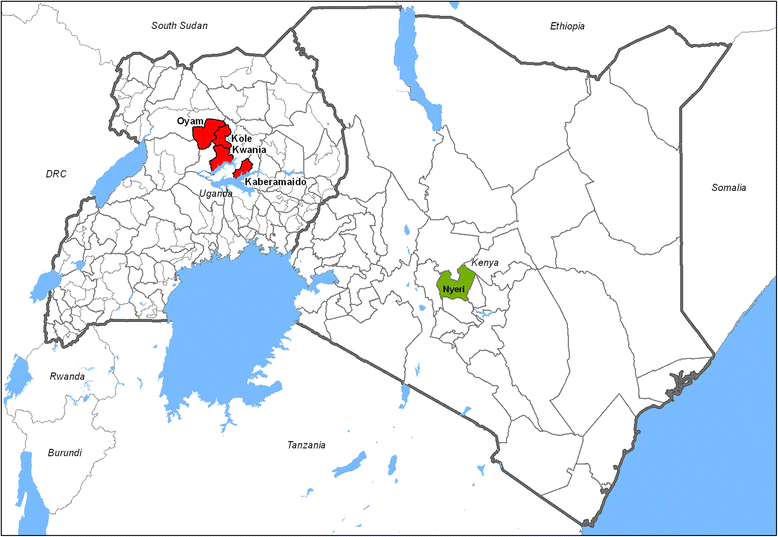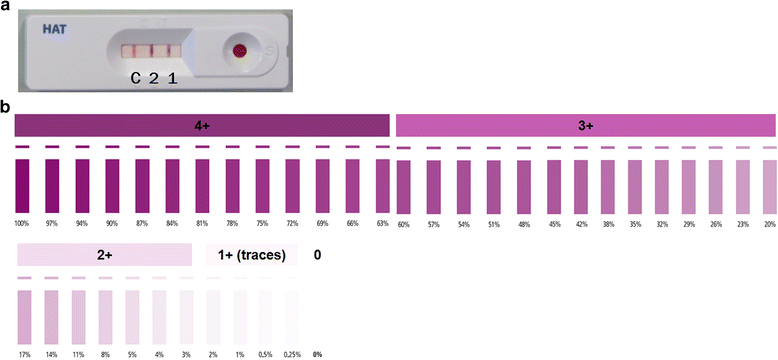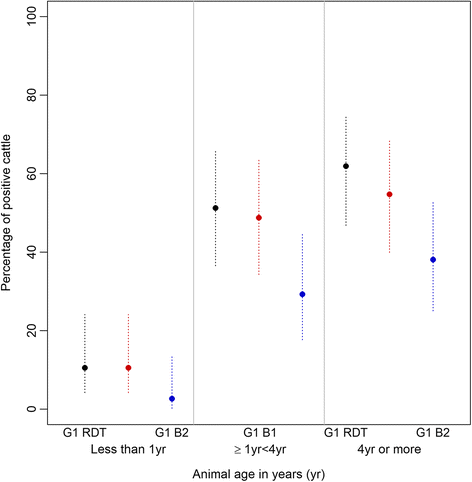Serological tests for gambiense human African trypanosomiasis detect antibodies in cattle
- PMID: 29100526
- PMCID: PMC5670715
- DOI: 10.1186/s13071-017-2487-8
Serological tests for gambiense human African trypanosomiasis detect antibodies in cattle
Abstract
Background: Serological tests for gambiense human African trypanosomiasis (gHAT) detect antibodies to antigens on the cell surface of bloodstream trypanosomes. As trypanosomes that cause animal African trypanosomiasis (AAT) also express related antigens, we have evaluated two rapid diagnostic tests (RDTs) on cattle in trypanosomiasis endemic and non-endemic regions, to determine whether gHAT serological tests could also be used to screen for AAT.
Methods: Two RDTs, 1G RDT, made with native antigens, and p2G RDT, made with recombinant antigens, were tested on 121 cattle in a trypanosomiasis-free region, and on 312 cattle from a rhodesiense HAT and AAT endemic region. A subset of samples from the endemic region were also tested with two immune trypanolysis (TL) tests. The sensitivity of the tests was estimated by evaluating the result of the RDT on samples that were positive by both microscopy and internal transcribed spacer (ITS) PCR, whilst specificity was the result of the RDT on samples that were negative by ITS PCR and microscopy, and others from the non-endemic region.
Results: The specificity of the p2G RDT on cattle from the non-endemic region was 97.5% (95% CI: 93.0-99.2%), compared to only 57.9% (95% CI: 48.9-66.3%) for 1G RDT. The specificities of 1G RDT, p2G RDT and TL on endemic control cattle were 14.6% (95% CI: 9.7-21.5%), 22.6% (95% CI: 16.4-30.3%) and 68.3% (95% CI: 59.6-75.9%), respectively. The sensitivities of the tests on trypanosome positive samples were 85.1% (95% CI: 79.1-89.7%), 89.1% (95% CI: 83.7-93.0%) and 59.3% (95% CI: 51.8-66.4%), respectively. Among the same samples, 51.7% were positive by both TL and the 1G RDT.
Conclusions: These serological tests detect cross-reacting antibodies in cattle. The p2G RDT based on recombinant antigens had a high specificity in a non-endemic region, while the 1G RDT had a lower specificity, suggesting cross-reactivity with other pathogens.
Keywords: Invariant surface glycoproteins; Serological tests; Specificity; Trypanosomes; Variant surface glycoproteins.
Conflict of interest statement
Ethics approval and consent to participate
Consent to take samples from cattle was given verbally by the owners.
Consent for publication
Not applicable.
Competing interests
AP, JMN and SB are employees of FIND, which co-developed the RDTs used in the present study. PB is a consultant for FIND. The authors declare no competing interests.
Publisher’s Note
Springer Nature remains neutral with regard to jurisdictional claims in published maps and institutional affiliations.
Figures



Similar articles
-
Specificity of serological screening tests and reference laboratory tests to diagnose gambiense human African trypanosomiasis: a prospective clinical performance study.Infect Dis Poverty. 2024 Jul 8;13(1):53. doi: 10.1186/s40249-024-01220-5. Infect Dis Poverty. 2024. PMID: 38978124 Free PMC article.
-
Performance evaluation of a prototype rapid diagnostic test for combined detection of gambiense human African trypanosomiasis and malaria.PLoS Negl Trop Dis. 2020 Apr 6;14(4):e0008168. doi: 10.1371/journal.pntd.0008168. eCollection 2020 Apr. PLoS Negl Trop Dis. 2020. PMID: 32251426 Free PMC article.
-
Development of multiplex serological assay for the detection of human African trypanosomiasis.Parasitol Int. 2016 Apr;65(2):121-7. doi: 10.1016/j.parint.2015.10.008. Epub 2015 Nov 10. Parasitol Int. 2016. PMID: 26519611
-
Options for field diagnosis of human african trypanosomiasis.Clin Microbiol Rev. 2005 Jan;18(1):133-46. doi: 10.1128/CMR.18.1.133-146.2005. Clin Microbiol Rev. 2005. PMID: 15653823 Free PMC article. Review.
-
[Diagnosis of human African trypanosomiasis in 2001].Med Trop (Mars). 2001;61(4-5):340-6. Med Trop (Mars). 2001. PMID: 11803824 Review. French.
Cited by
-
A review on the diagnosis of animal trypanosomoses.Parasit Vectors. 2022 Feb 19;15(1):64. doi: 10.1186/s13071-022-05190-1. Parasit Vectors. 2022. PMID: 35183235 Free PMC article. Review.
-
Experimental evidence that immune trypanolysis using the LiTat 1.3 and LiTat 1.5 variant antigen types is not specific to Trypanosoma brucei gambiense in pigs.Parasite. 2022;29:61. doi: 10.1051/parasite/2022063. Epub 2022 Dec 21. Parasite. 2022. PMID: 36562442 Free PMC article.
-
Accelerating elimination of sleeping sickness from the Guinean littoral through enhanced screening in the post-Ebola context: A retrospective analysis.PLoS Negl Trop Dis. 2021 Feb 16;15(2):e0009163. doi: 10.1371/journal.pntd.0009163. eCollection 2021 Feb. PLoS Negl Trop Dis. 2021. PMID: 33591980 Free PMC article.
-
Performance of diagnostic tests for Trypanosoma brucei brucei in experimentally infected pigs.PLoS Negl Trop Dis. 2023 Nov 9;17(11):e0011730. doi: 10.1371/journal.pntd.0011730. eCollection 2023 Nov. PLoS Negl Trop Dis. 2023. PMID: 37943881 Free PMC article.
-
A pilot study demonstrating the identification of Trypanosoma brucei gambiense and T. b. rhodesiense in vectors using a multiplexed high-resolution melt qPCR.PLoS Negl Trop Dis. 2020 Nov 25;14(11):e0008308. doi: 10.1371/journal.pntd.0008308. eCollection 2020 Nov. PLoS Negl Trop Dis. 2020. PMID: 33237917 Free PMC article.
References
Publication types
MeSH terms
Substances
LinkOut - more resources
Full Text Sources
Other Literature Sources
Research Materials
Miscellaneous

